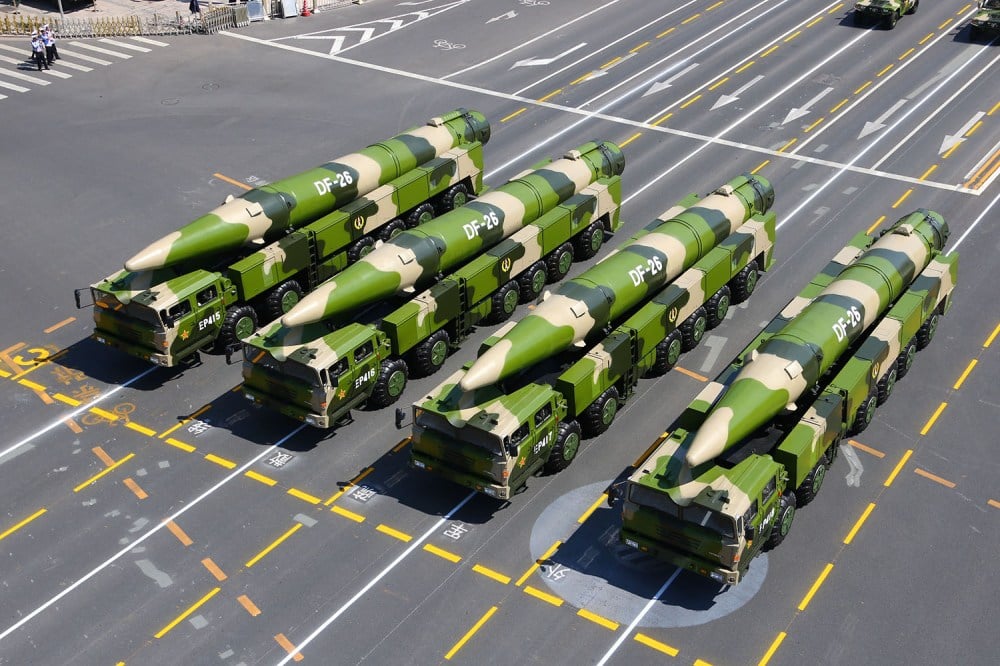Imagine China launching an invasion of Taiwan, and the United States decides to come to the island’s defense. Following the Pentagon’s doctrine and operational concepts for fighting such a war, the U.S. Navy and Air Force launch thousands of long-range missiles against Chinese ships, command centers, and logistics hubs. In the opening strikes alone, more than 33,000 precision-guided munitions target over 8,500 locations. Cyberattacks decimate Chinese military networks and paralyze the leadership. Beijing is forced to retreat or face defeat in what appears to be a swift, decisive U.S. success. Few U.S. lives are lost in this rapid, technology-driven triumph.

If this seems like the ideal scenario to you, you’d be wrong. For as precision strikes destroy Chinese missile launchers, command centers, and communications networks, Beijing’s military leaders face cascading military failures even as they are isolated by degraded communications. In a moment of panic about the rapid success of their adversary, the Chinese leadership may well consider vertical escalation—the use of nuclear weapons—before its remaining capabilities are eliminated. Beijing might authorize a demonstration nuclear strike over open waters as a signal of resolve and as an attempt to halt U.S. operations. It is then unclear whether Washington will interpret such a demonstration as justification for preemptive nuclear strikes against remaining Chinese capabilities.
It is not China’s nuclear doctrine per se that creates this dangerous escalation dynamic, but rather the United States’ preferred warfighting approach. Unlike Russia and the United States, with their much larger nuclear arsenals, Beijing may not yet believe that it can withstand a U.S. nuclear first strike and still have the ability to strike back—the critical deterrent against a nuclear first strike to begin with. China’s nuclear arsenal is rapidly expanding, but it is still small relative to that of the United States. (China had approximately 600 operational warheads as of 2024 compared to the United States’ estimated 3,700.) This vulnerability could compel Chinese leaders to use nuclear weapons early in a conflict rather than risk losing them to continued U.S. strikes.
The escalation risk is amplified by a particular aspect of Chinese armament: Its military possesses dual-capable missile systems and facilities that can launch both conventional and nuclear warheads. U.S. strikes against conventional DF-21 medium-range ballistic missile sites or DF-26 intermediate-range ballistic missile launchers and their command centers could be interpreted by Beijing as attacks on its nuclear deterrent, potentially triggering Chinese nuclear retaliation.
The DF-26 presents a particularly acute entanglement problem. These launchers come with conventional and nuclear warheads, which are often located on the same military bases. Brigades practice drills launching conventional attacks before reloading the launchers with nuclear warheads. If the United States targets these missile sites to prevent conventional strikes on U.S. forces, the Chinese leadership may interpret the attacks as aimed against the Chinese nuclear deterrent and as preparation for a U.S. nuclear first strike. In the heat of battle, this is a dangerous ambiguity that could inadvertently trigger nuclear escalation.
U.S. military planners are caught in an impossible dilemma. By continuing to focus on the kind of war they’ve always planned for—a rapid, decisive military campaign to paralyze Chinese forces and their leadership—they are increasing the risk of that leadership seeing no way out but escalation. At the same time, resource constraints make these U.S. warfighting plans unlikely to succeed in the first place.
The warfare approach that U.S. operational concepts favor—targeting Chinese Command, Control, Communications, Computers, Intelligence, Surveillance, and Reconnaissance (C4ISR) systems with long-range missiles and cyber effects—might also actually prolong and not diminish the prospects for long and destructive wars. These systems include everything from military communication networks to intelligence-gathering satellites and command headquarters that coordinate military operations.
Even if commanders are killed and command systems decimated in a mass barrage, planners should not assume that this translates into a quick victory. History suggests that forces often continue fighting until they’re physically destroyed. Consider that large numbers of Russian generals were killed in the first year of Russia’s war in Ukraine, yet the forces they commanded continue operations to this day. Hamas, Hezbollah, and the Islamic State remained effective military forces despite targeted decapitation—until their forces were systematically destroyed in grinding military campaigns.
However, the uncomfortable truth is that the United States is not prepared for anything close to a grinding war of attrition in East Asia. In recent war games, the U.S. military was projected to exhaust its stockpile of maritime strike missiles in just three days and its entire inventory of standoff land-attack weapons in 10 to 14 days. Other munitions categories did not fare better. War games showed that Taiwan, with the aid of the United States and Japan, defeated a Chinese amphibious invasion in most scenarios, but this victory came at a devastating cost: dozens of U.S. ships sunk, hundreds of aircraft destroyed, and tens of thousands of U.S. servicemembers killed. Recent news that the Pentagon is urgently pushing missile suppliers to double or even quadruple production of critical weapons, including long range anti-ship missiles and precision strike missiles should be welcomed. But it does not solve the escalation problem: The preferred U.S. warfighting concept makes a nuclear exchange more, not less, likely.
Given Washington’s long and outsized influence on military thinking within NATO, these risks extend far beyond the Pacific. During recent workshops with NATO war planners and German high-ranking military officers that I attended, both groups confessed to a troubling gap between their own plans for fighting a potential war with Russia and how political leaders in capitals like Berlin envision such confrontations unfolding. The escalation mechanics built into the U.S. military’s operational concepts are poorly understood outside military circles—and sometimes not well understood within them.
Nuclear strategists often brush off escalation concerns, embracing bold actions under the banner of deterrence. They echo Gen. Ulysses S. Grant’s admonishment to his officers during the 1864 Overland Campaign, who feared what Confederate Gen. Robert E. Lee might have up his sleeve. “Go back to your command and try to think what we are going to do ourselves, instead of what Lee is going to do,” Grant reportedly said.
To some degree, the strategists downplaying escalation risks are right. The mere possibility of nuclear escalation should not prevent the United States from fighting China—that would be self-deterrence, which could mean losing a war before it is fought. But if the United States is preparing for the possibility of having to fight, it needs to be clear about the final goals, acceptable risks, and ways to mitigate those risks.
A better way forward would be what I would call a “smart attritional approach.” This would adapt the Pentagon’s deterrence-by-denial strategy by focusing on beating back a Chinese invasion without necessarily triggering vertical escalation. This approach deliberately avoids widespread strikes on command and control assets that are potentially linked to China’s nuclear deterrent, recognizing that such attacks could be perceived by Beijing as existential threats to the survival of the Communist Party regime.
Such an adapted strategy accepts that modern warfare between great powers will likely be characterized by conventional attrition. It prioritizes investments in weapons systems that deliver greater firepower in close combat: expanded torpedo production for the war at sea, shorter-range unmanned systems operating at scale, and medium-to-long-range air and missile defense systems positioned to repel invasion forces.
This doesn’t mean abandoning existing deep strike capabilities entirely, but rather reverting to their original role as tools to shape the battlespace rather than as the decisive shortcut to victory or defeat. It means accepting that technological superiority alone cannot guarantee swift success against a peer competitor.
Unfortunately, embracing a smart attritional approach may not be feasible due to the continued inability of the United States to commit the necessary resources, which in turn stems from the absence of political and social consensus about the need to militarily confront China over Taiwan in the first place. Indeed, losing one-half to two-thirds of U.S. Air Force and Navy assets, not to mention thousands of service members, for the preservation of an independent Taiwan, as some war games project, might not represent the best long-term strategy for a global power like the United States.
The basis for any strategy, therefore, is an honest conversation about what Americans are willing to sacrifice for Taiwan’s independence. As military historian Michael Howard noted, the West has been “sailing through the fog of peace.” The greater the distance from the last great power war, the greater the chance of a catastrophic error.
The path forward requires abandoning comfortable illusions. If the United States chooses to defend Taiwan, it must build the industrial capacity for protracted conflict, embrace operational concepts that minimize escalation risks, and honestly communicate to the American people what such a war would cost and why it would be fought. What the U.S. military cannot do is to continue sailing through the fog of peace and pretend that technological superiority guarantees swift success, that escalation risks are manageable, and that wartime realities will align with peacetime assumptions. To borrow from the great Athenian strategist Thucydides: The next great power war will be a stern teacher.
The post Is the U.S. Ready for War With China? appeared first on Foreign Policy.




